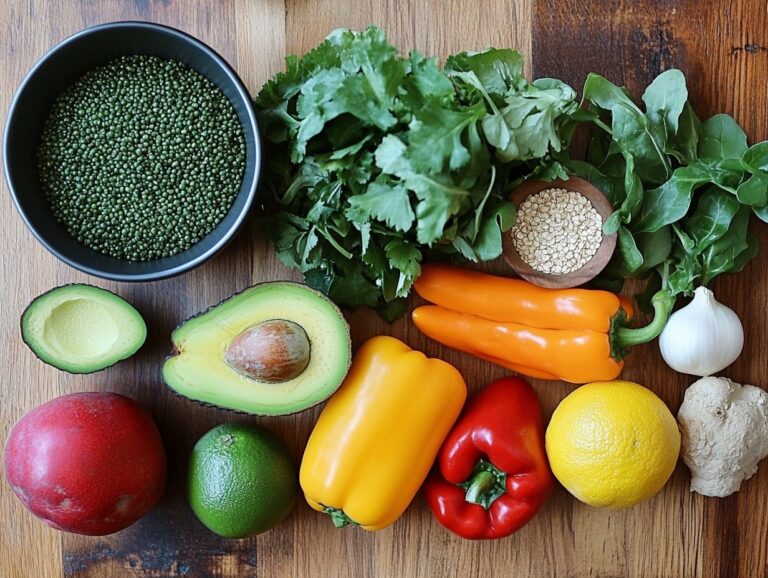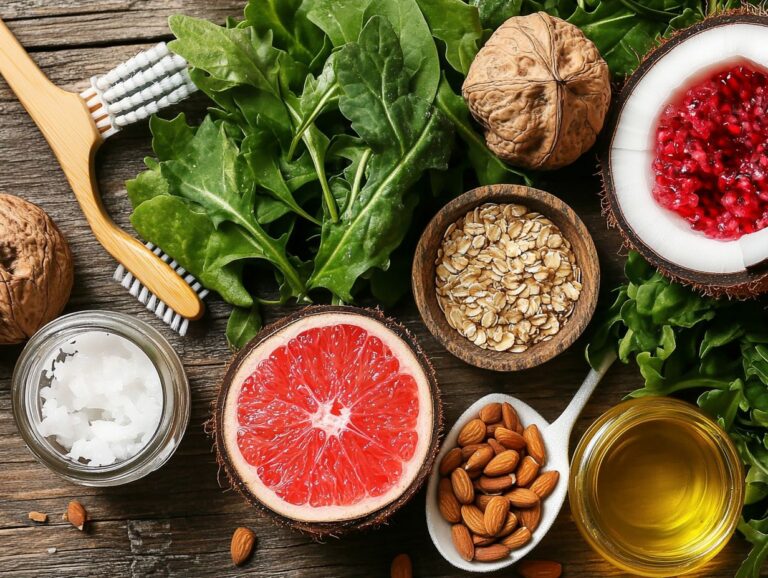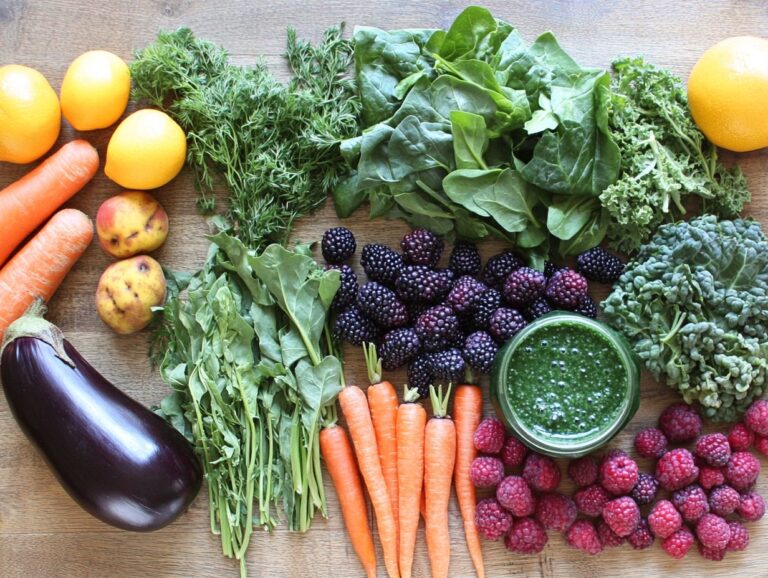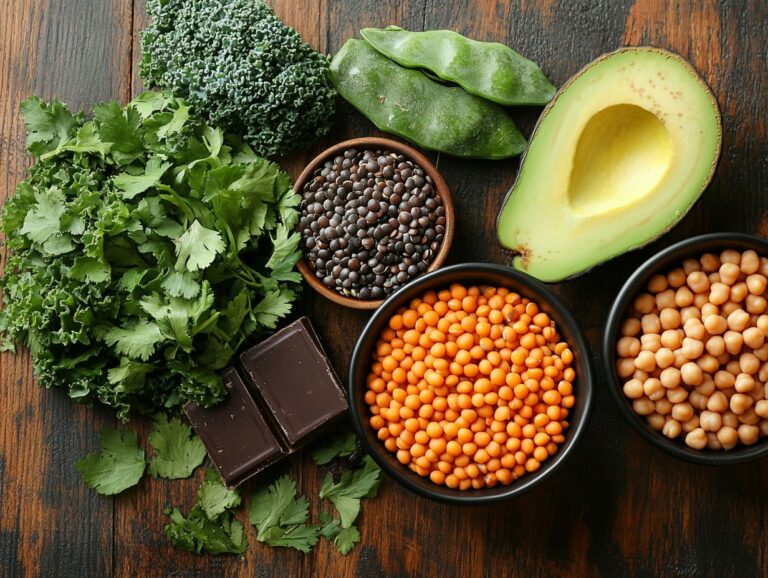Are you curious about the raw vegan diet and how it can transform your eating habits with exciting raw vegan recipes such as spinach macadamia ricotta cannelloni and watermelon sushi?
This lifestyle emphasizes consuming unprocessed foods in their natural state, offering a plethora of health benefits, with options like raw lasagne and curried swede risotto.
We explore the fundamental principles of a raw vegan diet, the foods you can enjoy such as rainbow spring rolls, and the advantages of embracing this vibrant way of eating.
Additionally, there are simple, mouth-watering raw vegan recipes like blackberry cheesecake and protein balls and tips for transitioning smoothly. Get ready to discover a fresh approach to nutrition!
Key Takeaways:
- A raw vegan diet consists of eating only uncooked, unprocessed plant-based foods.
- Planning a raw vegan diet involves stocking up on fresh fruits and vegetables, incorporating nuts and seeds, and experimenting with grains and legumes.
- To ensure proper nutrient intake on a raw vegan diet, focus on variety, supplement with vitamins, and consider adding protein sources.
What Is a Raw Vegan Diet?

A raw vegan diet is a lifestyle choice that merges the principles of veganism with the consumption of unprocessed and uncooked plant-based foods.
This dietary approach emphasizes fresh fruits, vegetables, nuts, seeds, and sprouted grains, ensuring individuals receive essential nutrients while avoiding animal products and processed foods.
By following a raw vegan diet, individuals may experience numerous health benefits, enhance their overall well-being, and adopt a more sustainable lifestyle.
Many people are increasingly attracted to raw veganism due to its simplicity and strong connection to health and wellness.
What Are the Basic Principles of a Raw Vegan Diet?
The core principles of a raw vegan diet revolve around consuming unprocessed, plant-based foods while avoiding all forms of animal products and refraining from cooking at temperatures above 118°F (48°C). This approach helps to preserve the natural enzymes and nutrients present in these foods.
The diet emphasizes whole foods, including fresh fruits, vegetables, nuts, and seeds, to maximize antioxidant and nutrient intake, with delicious dishes like jalapeno popper dip and black sesame arame sauce.
- Berries and leafy greens are excellent sources of vitamins and minerals, perfect for a rainbow pad Thai zucchini noodle salad,
- while nutrient-dense nuts and seeds provide healthy fats and protein, as seen in portobello meatloaf.
These components support digestion and overall well-being, as the intake of raw ingredients, such as mooli noodles with sweet chili mango sauce, facilitates efficient absorption of nutrients by the body.
What Foods Are Allowed on a Raw Vegan Diet?
A raw vegan diet consists of a diverse array of healthy, unprocessed foods that are entirely plant-based, including fresh fruits, vegetables, nuts, seeds, and sprouted grains. This diet is rich in essential nutrients, fiber, and antioxidants, promoting good health and aligning with environmentally friendly practices.
Fruits such as blueberries and bananas offer vital vitamins and minerals, while leafy greens like kale and spinach are high in iron, calcium, and vitamins A, C, and K. Nuts, including almonds and walnuts, contribute healthy fats and protein, which are crucial for muscle repair and heart health. Seeds like chia and flaxseeds are excellent sources of omega-3 fatty acids, essential for brain function.
Sprouted grains, such as quinoa and brown rice, enhance nutrient absorption and provide complex carbohydrates for sustained energy. The wide variety of foods in a raw vegan diet allows for numerous dishes and recipes while delivering maximal health benefits.
What Are the Benefits of a Raw Vegan Diet?
The benefits of a raw vegan diet include improved nutrition, weight loss, increased energy, a reduced risk of chronic diseases, and better digestion—demonstrated by meals such as double decker black bean and corn tacos and vegan broccoli salad.
These advantages primarily stem from the high consumption of fresh fruits, vegetables, nuts, and seeds, which are rich in vitamins, minerals, and antioxidants. Adopting a raw vegan diet can enhance digestion, as the high fiber content in raw plant foods promotes gut health and regularity.
Additionally, this diet aids in detoxification, allowing the body to naturally eliminate toxins, resulting in a refreshed and energized feeling. The raw vegan diet can also boost vitality due to its abundance of living enzymes and nutrients that support the efficient use of fuel.
Other potential benefits of a raw vegan diet include clearer skin and improved mental clarity.
How to Plan a Raw Vegan Diet?
A raw vegan diet is defined by a variety of whole foods, including fruits, vegetables, nuts, and seeds.
Careful planning is essential to ensure that individuals receive adequate nutrition. When planning a raw vegan diet, it is important to include a diverse range of food components in meals to maintain a proper nutritional balance.
1. Stock Up on Fresh Fruits and Vegetables
Stocking up on fresh fruits and vegetables is a fundamental step in planning a raw vegan diet, as these foods are rich in essential vitamins, minerals, and antioxidants that support overall health and wellness.
Choosing a diverse range of produce not only enhances the flavor and color of meals but also ensures a wide spectrum of nutrients is included. When selecting seasonal fruits and vegetables, it’s beneficial to visit local farmers’ markets or grocery stores that prioritize fresh, organic options.
Seasonal produce tends to be more flavorful and nutrient-dense because it is harvested at its peak ripeness. For instance, berries and cucumbers are excellent choices in the summer, while root vegetables like carrots and beets are at their best in the fall.
This thoughtful selection can significantly contribute to a balanced raw vegan diet, maximizing benefits such as improved digestion and increased energy levels.
2. Incorporate Raw Nuts and Seeds
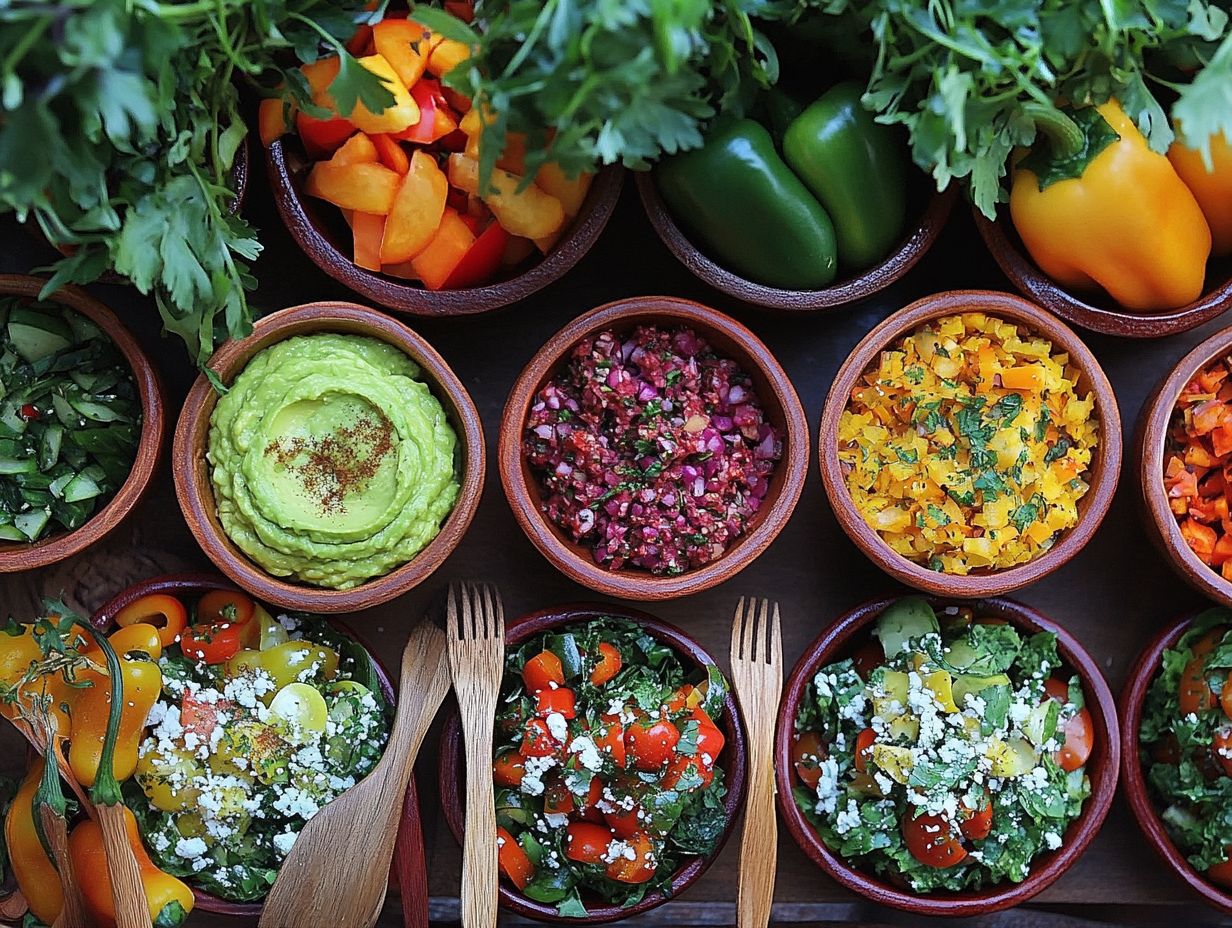
Nuts and seeds are essential components of a raw vegan diet, as they provide healthy fats, protein, and micronutrients that fruits and vegetables may lack, contributing to overall nutritional adequacy.
These whole food sources are rich in vital nutrients, such as omega-3 and omega-6 fatty acids, which are crucial for cardiovascular and brain health. Additionally, nuts and seeds serve as excellent plant-based protein supplements, supporting the maintenance and growth of muscle mass.
Their natural versatility allows them to be easily blended into smoothies, added to salads, or used as a crunchy topping for raw desserts. Incorporating nuts and seeds into daily meals not only enhances the nutritional profile but also adds rich texture and flavor to every bite.
3. Include Healthy Fats
Healthy fats are essential in a raw vegan diet to ensure adequate caloric intake and proper nutrient absorption. Avocados, nuts, and seeds are some of the most common sources of healthy fats among raw vegans.
These nutrient-dense foods provide high energy density and are rich in essential fatty acids that are crucial for cardiovascular health and brain function. For example, walnuts and flaxseeds are abundant in omega-3 fatty acids, which possess anti-inflammatory properties, while almonds and cashews are high in heart-healthy monounsaturated fats that can help lower cholesterol levels.
Including these healthy fats enhances the absorption of fat-soluble vitamins A, D, E, and K, enabling those following a raw vegan lifestyle to achieve proper nutrition. By intentionally incorporating a variety of these sources, the overall quality of the diet can be significantly improved, all while enjoying delicious flavors.
4. Experiment with Raw Grains and Legumes
Experimenting with raw grains and legumes can significantly enhance the variety and depth of a raw vegan diet. Sprouted grains and legumes offer additional nutrition, fiber, and protein while retaining the health benefits associated with raw foods.
Incorporating these nutrient-dense ingredients not only elevates flavor but also improves digestibility, making it easier for the body to absorb essential vitamins and minerals. The sprouting process involves soaking grains and legumes in water to initiate germination and can be performed with a range of options, such as quinoa, lentils, or chickpeas.
This method boosts their nutritional profile, increasing levels of antioxidants, vitamins, and enzymes. For those transitioning to a raw vegan lifestyle, simple techniques like blending sprouted grains into smoothies or adding them to salads can create satisfying dishes.
Additionally, experimenting with different sprouting times can yield varied textures and flavors, making each meal unique and appealing.
Simple and Delicious Raw Vegan Diet Recipes
The significance of raw vegan recipes for achieving nutritional balance is clear, as is the enjoyment of discovering diverse tastes and textures.
This highlights the demand for simple, easy, and delicious raw vegan meals like no bake protein balls and artichoke picnic sandwich.
1. Raw Zucchini Noodle Salad
The raw zucchini noodle salad is a refreshing and nutritious dish that highlights the versatility of raw ingredients. It combines spiralized zucchini with a variety of colorful vegetables and a tangy dressing, resulting in a satisfying meal.
Prep Time: 25 mins
Cook Time: 0 mins
Total Time: 25 mins
Course: Salad
Cuisine: Mediterranean
Servings: 4 servings
Calories: 191 kcal
Ingredients:
- 4 medium zucchini, spiralized into noodles, perfect for this and the Thai zucchini noodle salad
- 1 bell pepper, diced
- 1 small carrot, peeled and shredded
- 1 cup cherry tomatoes, quartered
- 1 stalk green onion, diced
- ¼ cup cilantro (or parsley), chopped
- ¼ cup (40 g) feta cheese, crumbled
For the Lemon-Dijon Dressing:
- ¼ cup (60 ml) olive oil
- ¼ cup (60 ml) fresh lemon juice
- 2 teaspoons Dijon mustard
- Salt and pepper to taste
- 1 tablespoon of black sesame seeds for an added crunch
Instructions:
- In a small bowl, mix together the olive oil, lemon juice, and mustard. Season to taste with salt and pepper, then set aside.
- In a large bowl, combine the spiralized zucchini noodles, bell pepper, carrot, tomatoes, green onion, cilantro, and feta cheese. Drizzle the lemon-Dijon dressing over the salad and toss gently to combine. Serve immediately.
Recipe Notes:
- Ensure the zucchini is dry before spiralizing; drier zucchini will hold their shape and texture better.
- Store any leftover salad in an airtight container in the refrigerator for up to 2 days. To prevent the zucchini from becoming too mushy, store the dressing separately and add it just before serving. You may also want to reserve some of the cheese as a garnish for serving.
2. Creamy Avocado and Cucumber Soup
Creamy avocado and cucumber soup is a delightful raw vegan dish that combines ripe avocados and crisp cucumbers into a smooth, refreshing soup, making it perfect for warm days. This vibrant culinary creation not only pleases the palate but also offers a wealth of health benefits, making it a nutritious addition to any meal.
Packed with healthy fats from avocados, which are rich in monounsaturated fats that support heart health, along with low-calorie cucumbers that hydrate and provide essential vitamins, this soup is both nourishing and satisfying.
To prepare it, simply blend the avocados and cucumbers with fresh herbs such as dill or mint for added flavor, a squeeze of lemon juice for brightness, and a dash of salt. The result is a silky texture that is both satisfying and revitalizing, making it an excellent choice for a light lunch or an appetizer at any gathering.
3. Raw Vegan Pad Thai
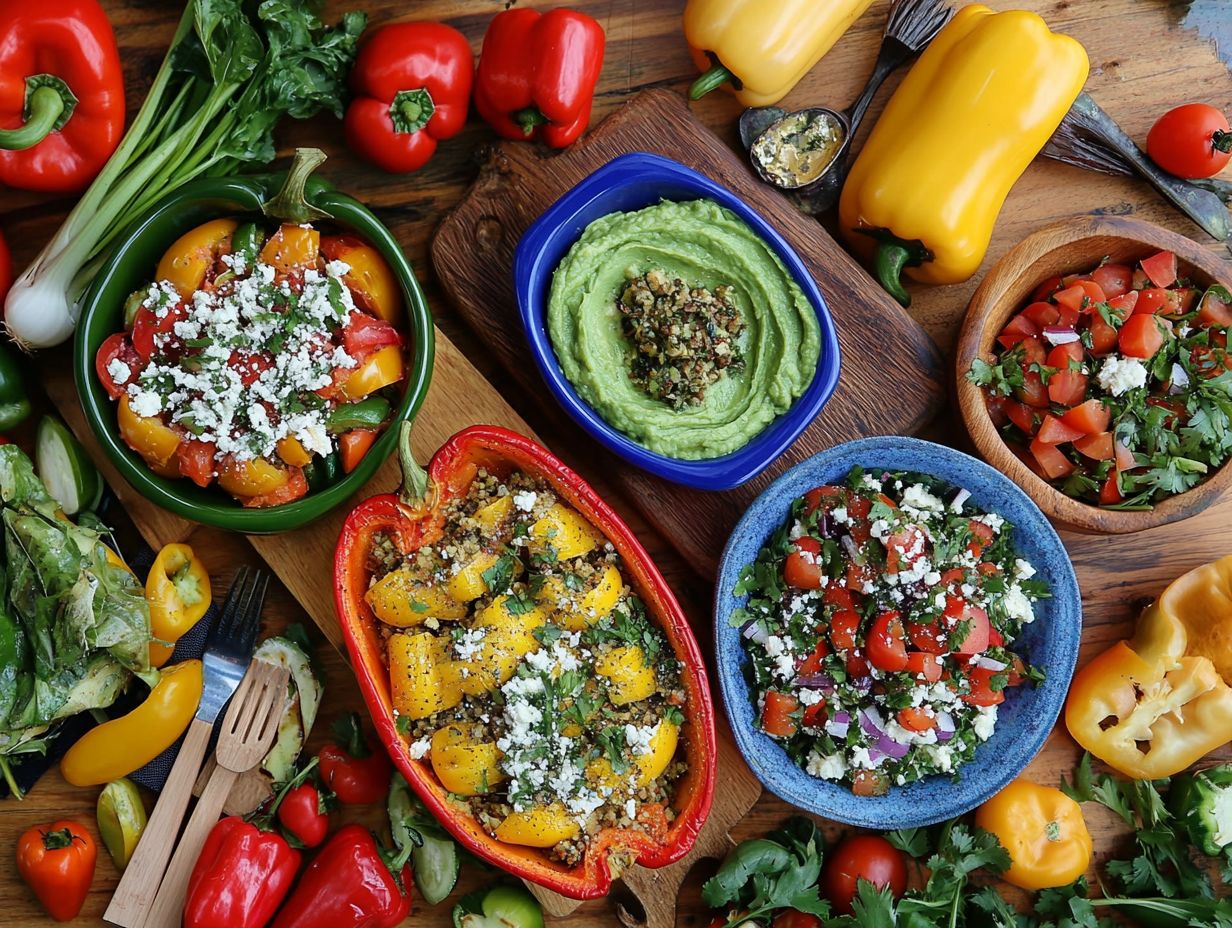
Raw vegan pad Thai offers a creative twist on the traditional dish by featuring spiralized vegetables, a flavorful sauce, and garnishes that create a nutritious and satisfying meal without any cooking.
This vibrant dish highlights the beauty and versatility of plant-based ingredients, resulting in a delightful combination of textures and flavors that tantalize the palate.
Instead of traditional noodles, zucchini and carrots are expertly spiralized to form a base that mimics the texture of pad Thai. The sauce, a rich blend of almond butter, lime juice, and tamari, adds depth and creaminess while supplying essential healthy fats and protein.
Topped with crushed peanuts, fresh herbs, and a sprinkle of sesame seeds, this raw vegan pad Thai not only excels in taste but also provides a wealth of vitamins, minerals, and antioxidants, making it an excellent choice for those seeking a nourishing meal that supports a healthy lifestyle.
4. Raw Vegan Tacos
What are raw vegan tacos? Raw vegan tacos are a type of lettuce wrap or dehydrated taco-style shell filled with a variety of fresh vegetables, nuts, seeds, and spices. They aim to recreate the flavors of traditional tacos without using meat or dairy.
These tacos are a fun and creative way to enjoy taco flavors and can be adapted to meet various dietary restrictions, such as gluten-free or nut-free options. Along with being delicious, raw vegan tacos are a good source of vitamins and minerals, making them an excellent choice for those looking to increase their intake of fruits and vegetables.
Ingredients in Raw Vegan Tacos
Common ingredients in raw vegan tacos include:
- Avocados
- Tomatoes
- Bell peppers
- Onions and garlic
- Cilantro
- Mushrooms
- Zucchini
- Walnuts and pecans
- Spices and natural flavorings
Benefits of Eating a Raw Vegan Diet
A raw vegan diet consists of raw fruits, vegetables, nuts, seeds, and grains, while avoiding cooked, processed, or refined ingredients. Eating raw foods is believed to preserve the enzymes that aid in digestion and nutrient absorption. High-heat cooking can destroy these enzymes, making it more difficult for the body to absorb nutrients.
Since raw vegan tacos incorporate fresh, healthy ingredients, they are often highly nutritious meals. They can be customized for various dietary restrictions, such as vegetarian or gluten-free, and are typically loaded with fresh vegetables, nuts, and spices, resulting in a delightful variety of textures and flavors.
How to Make Raw Vegan Tacos
Besides being highly nutritious, raw vegan tacos are easy to prepare and can be customized to fit any schedule or event, whether it’s a quick lunch on the go or an elaborate meal shared with friends.
5. Raw Vegan Chocolate Pudding
Raw vegan chocolate pudding is a decadent yet healthy dessert that combines raw cacao with avocados and natural sweeteners, resulting in a guilt-free treat rich in nutrients. This delightful dessert not only satisfies chocolate cravings but also serves as an excellent source of healthy fats, vitamins, and minerals.
To prepare this indulgent treat, simply blend ripe avocados, raw cacao powder, and a natural sweetener such as maple syrup or agave. For an added depth of flavor, you can enhance the pudding with a splash of vanilla extract or a pinch of sea salt.
This delicious pudding is creamy and luxurious, packed with antioxidants from the cacao, fiber from the avocados, and essential nutrients. It makes a great choice for anyone seeking a health-conscious dessert option that doesn’t compromise on taste.
How to Make Sure You’re Getting Enough Nutrients on a Raw Vegan Diet?
Discover delightful raw vegan recipes such as spinach macadamia ricotta cannelloni, watermelon sushi, and a Mexican platter to diversify your meals.
Raw vegan diets should incorporate a diverse range of foods, require careful planning, and focus on nutrient-rich options to ensure that all essential vitamins, minerals, and proteins necessary for good health are consumed in adequate amounts.
1. Focus on Variety
Variety in a raw vegan diet is essential for maximizing nutrient intake, as different fruits, vegetables, nuts, and seeds offer unique vitamins, minerals, and phytonutrients that support overall health. Try incorporating spinach macadamia ricotta cannelloni or watermelon sushi for a creative twist on classic dishes.
Incorporating a wide range of these foods ensures that meals are not only tasty and enjoyable but also provide a more comprehensive array of essential nutrients necessary for the body to function effectively.
For instance, dark leafy greens are rich in calcium and iron, while citrus fruits supply vitamin C, which enhances iron absorption. Nuts and seeds, such as sunflower and hemp seeds, contribute healthy fats and protein, promoting heart health and muscle maintenance.
A diverse diet also supports a balanced gut microbiome, strengthens the immune system, and reduces the risk of chronic diseases. This demonstrates that variety is not merely a matter of taste, but a fundamental aspect of nutritional health.
2. Supplement with Vitamin B12 and D
Consider adding easy raw vegan recipes like no bake protein balls or blackberry cheesecake to your diet, which can be fortified with additional nutrients.
Supplementation of vitamins B12 and D is common in raw vegan diets, as these nutrients are primarily found in animal products. To ensure proper nutritional intake, individuals following a raw vegan diet must rely on supplementation or processed foods.
Maintaining adequate levels of vitamins B12 and D is crucial, as a deficiency in vitamin B12 can lead to anemia or neurological issues, while a deficiency in vitamin D can result in conditions such as rickets or osteomalacia.
Since raw vegan diets typically do not provide sufficient amounts of these vitamins, individuals must seek fortified foods or high-quality supplements. Vitamin B12 can be found in fortified plant-based milks and cereals, while vitamin D can be obtained through sun exposure or supplements containing D2 or D3 derived from lichen.
3. Consider Adding Protein Sources
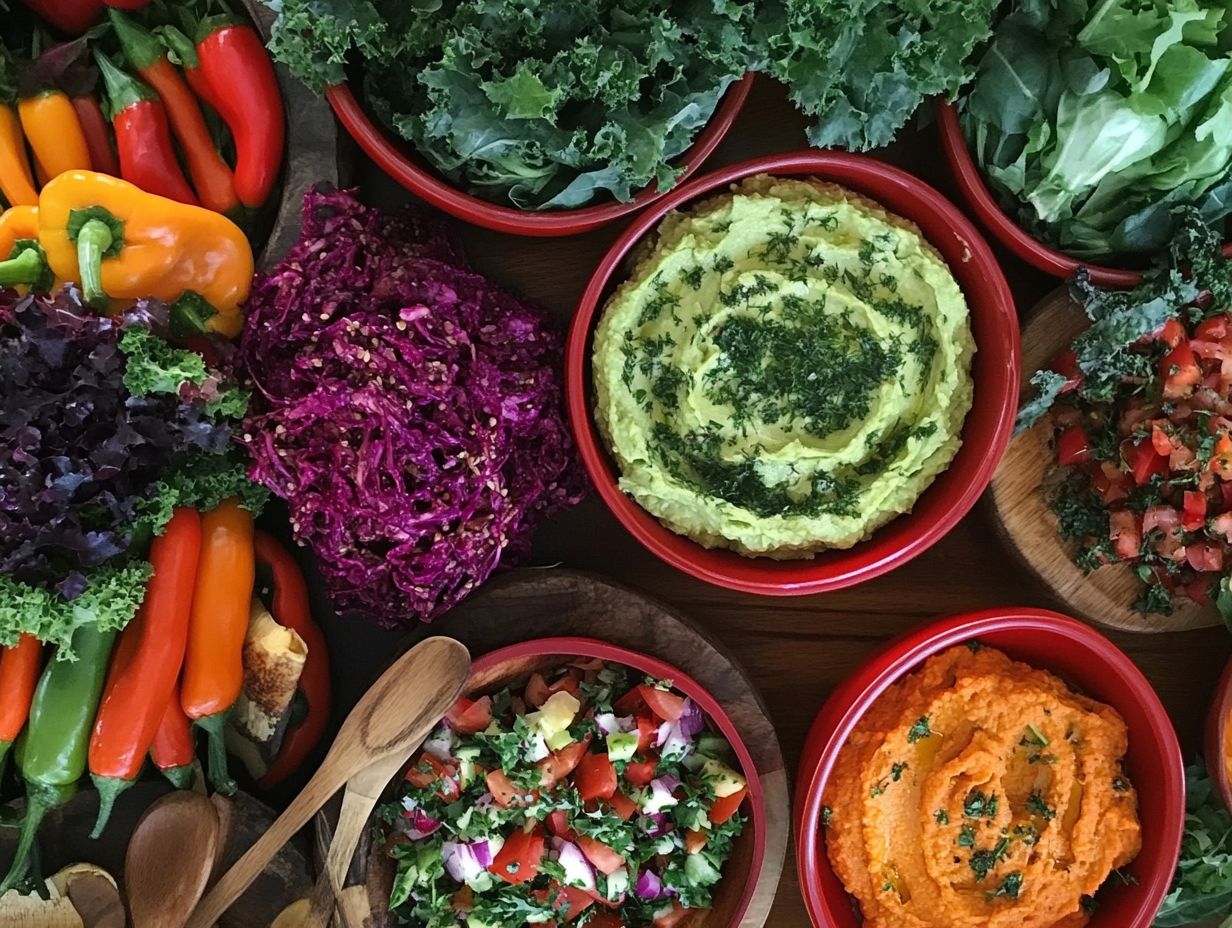
In a raw vegan diet, sources of plant-based protein include nuts, seeds, legumes, and certain grains. These foods are essential for muscle health and overall well-being, as they provide the amino acids necessary for muscle repair and growth, along with other vital nutrients.
For instance, almonds and chia seeds are excellent sources of healthy fats and fiber, which are important for heart and digestive health. Lentils and quinoa are also significant sources of plant-based protein, offering substantial amounts of iron and magnesium that contribute to energy levels.
Incorporating a variety of these raw foods helps ensure that individuals can meet their daily protein needs while also obtaining many of the vitamins and minerals essential for overall good health.
The diverse range of options available means that a raw vegan diet can support thriving health.
Tips for Making the Transition to a Raw Vegan Diet
Transitioning to a raw vegan diet can be a rewarding experience when you follow these practical tips to make the process enjoyable and sustainable for those pursuing a healthier lifestyle.
1. Start Slowly
For those newly adopting a raw vegan lifestyle, starting slowly is essential. This approach allows individuals to adapt their taste buds and digestive systems to new foods while preventing feelings of being overwhelmed.
A gradual transition enables people to explore a variety of raw fruits, vegetables, nuts, and seeds without feeling rushed. For beginners, incorporating a few easy-to-prepare raw meals can facilitate their adjustment to the diet.
For instance, a smoothie made with bananas and spinach serves as a simple breakfast option, while a fruit salad featuring seasonal berries and mangoes makes for a quick and energizing morning choice.
As individuals become accustomed to consuming larger amounts of raw food, they can introduce raw snacks such as double decker black bean and corn tacos, jalapeno popper dip, or smoothie bowls enhanced with crunchy cashew toppings.
- Carrot sticks
- Celery sticks
- Bell pepper sticks
- Spinach leaves
- Portobello mushrooms
- Zucchini strips
These can be paired with hummus or a handful of mixed nuts. This method allows people to increase the variety of foods they enjoy while reaping the benefits of raw nutrition.
2. Get Creative with Recipes
Creativity in recipes is a vital aspect of a raw vegan diet, as it encourages individuals to explore new and diverse flavor combinations like watermelon sushi or rainbow spring rolls, ensuring they receive the necessary nutrition and satisfaction.
By experimenting with a variety of ingredients such as fresh fruits, vegetables, nuts, and seeds, one can develop unique and delicious combinations. The versatility of raw vegan foods offers endless possibilities, including raw tacos wrapped in lettuce, vibrant salads, and even desserts.
Embracing creativity not only makes cooking enjoyable but also fosters innovation in the kitchen. It is often the case that attempting ideas that may initially seem bizarre or unconventional can lead to surprisingly delicious results.
3. Listen to Your Body and Explore New Recipes
Listening to your body during the transition to a raw vegan diet is crucial, as it helps you make informed dietary choices and adjustments, while exploring new recipes like easy raw vegan Mexican platter or avocado caprese with sweet balsamic dressing, to ensure that the diet is healthy for you as an individual.
Individual needs and responses to foods can vary significantly from person to person. Being attentive to signals related to hunger, energy, and overall nutrition can be incredibly beneficial during this transition. Recognizing when your body is requesting food or when it is fatigued can give the power to you to proactively explore new food choices and determine how often to eat.
Additionally, being aware of how you feel while consuming raw foods—such as how they feel in your body and their taste—will enhance your understanding of how raw food affects you personally. This insight can guide you in identifying the nutrients you need to obtain from raw fruits, vegetables, nuts, and seeds to maintain your health.
4. Seek Support from Others
The most effective way to transition to a raw vegan diet is to seek support from others. Surrounding yourself with like-minded individuals can provide motivation, as well as opportunities to share resources and recipes.
